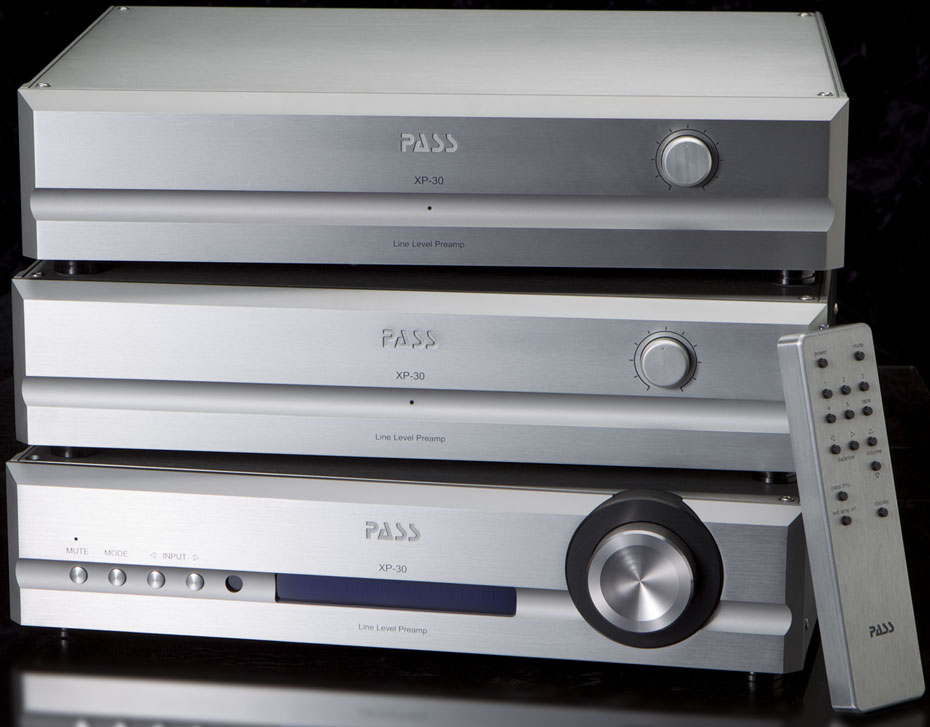
This brings me to the subject at hand – the three-piece Pass Labs XP-30 preamp. I will get right to it. This is not only among the best preamps I’ve heard at any price range – it is now my personal favorite all-time preamp. Consequently, when you read this review you will need to account for the fact that this component grabbed me from the first listen, both in terms of its objective technical excellence and it’s subjective presentation. I’ll endeavor to provide objective comparisons to other preamps, but be warned that my personal taste and system synergy may cause this review to be biased in favor of this preamp!
A Little Background
For perspective, here is a list of the preamps I have owned, reviewed, or had in my home system for at least a full week, roughly in chronological sequence:
Adcom GFP-750
Cary SLP-2002
Ayre K5-x
Sphinx Project Eight
XLH SL-11XS
Pass Labs X0.2
MBL 5011
BAT VK 40
Plinius Tautoro
Pass Labs XP-20
Ypsilon PST-100 Mk2
MBL 6010D
Sheng Ya CS-6
Electrocompaniet 4.8
Linn Akurate Kontrol
So I’ve seen and heard a few preamps in my time. Of course, these were in my system at different times, which means that they were matched with different sources, cables, amps and speakers. Consequently, I can’t say that I’ve compared each head-to-head, but I’ve had a pretty good range of experience.
I’ve also gone extended periods of time without using a preamp, which is a very instructive experience because the transparency to the source is outstanding; if you can address the likely loss in dynamics, you can find a preampless system quite addicting. My system was in such a “preampless” state when the XP-30 arrived. I have been using either a Lessloss DAC 2004 with the analog volume control option, or a specially-featured MBL 6011 E (but modified with the F board) DAC which incorporates MBL’s great analog volume control, multiple digital inputs and an analog input. I have not had any issues with dynamics or PRaT, probably in part because in my main room’s equipment chain the DAC is followed by a Lyngdorf RP-1, which provides some added gain. Recent preamps that have been inserted between the DAC and the RP-1 have not done anything to improve the sound and some have degraded it in some minor way. This means that my main system is a big challenge for any preamp that is thrown at it.
On the other hand, I also have a nice-sounding secondary system which has a DAC/digital receiver with a digital volume control. This system is great for testing any kind of preamp because the DAC clearly sounds its best when its volume is set at or near maximum. My testing was done in both systems.
This Puppy Has Some Nice Features
Though it’s obvious that the sound is the most important “feature” of the XP-30, there are plenty of operational features to satisfy pretty much any user. The XP-30 is a 3-chassis unit consisting of one control/power supply chassis and two gain chassis. Each of the gain chassis contains the circuits of a single analog channel. The only apparent difference between each gain chassis is that the inputs and outputs on one gain chassis are ringed in red and the ones on the other are ringed in white.
Each gain chassis has five inputs as well as a bypass input for a home theater processor, and a tape input and output for recording or additional signal processing. The home theater bypass can also be reset to operate as a regular sixth input if your system has need for that many inputs. Each input is available in either XLR or RCA. If you use an RCA input you need to disable the corresponding XLR input with the supplied shorting plugs.
The outputs of each gain chassis also come in both XLR and RCA formats, but can be used simultaneously. Further, there are two outputs for each chassis – one labeled “Master” and one labelled “Slave.” This is a nifty combination of four simultaneously active outputs, because the relative output level between the Master and Slave outputs can be manually adjusted by a knob on the front panel of each individual gain chassis. This allows for easy biamping, allowing you to gain-match differing amps, as well as making the minor adjustments that are necessary even when you’re using identical amps for biamping. This is a fabulous feature that every audiophile should take advantage of whenever he or she can afford it.
Each gain chassis also has an XLR “mono” input which is connected to the other gain chassis with a supplied connector for pure mono operation.
The gain chassis are each connected to the control chassis by a supplied DIN-25 cables. There are two of these DIN-25 inputs on each chassis, and you can connect to either one. The additional DIN-25 input allows you to daisy chain additional gain chassis – up to a total of six! Combined with the aforementioned ability to biamp with just the basic two gain chassis, this actually allows you even further flexibility to biamp, triamp, add additional subwoofers, etc. Pass Labs claims that you can do all this with absolutely no degradation of the signal, and I certainly couldn’t detect any loss of fidelity in my experimentation with multiple amps in the basic 2-chassis setup.
As if all of this was not enough, the internal gain of each stage can be boosted another 16 dB via an internal jumper, making the preamp an ideal low source impedance front-end for power follower amplifiers, which Nelson Pass apparently believes will become more prevalent. As I understand it, a power follower is an amp that provides current gain, but has a voltage gain of nearly 1. If that is the case, your XP-30 will be totally ready for such amps. On a more immediate level, the output impedance of each channel of the XP-30 is 120 Ohms, which is quite low and will have no trouble driving long cable runs and/or amps with low input impedances.
Finally, I need to mention the VOLUME CONTROL, which has 99 steps and whose gain range goes from -90 dB to + 10 dB. I like my MBL’s volume control a lot, but it is very tough to get right at low volume levels. This was never the case with the Pass. The volume settings at any level sound perfectly balanced with gobs of detail and can easily be adjusted to exactly the level you want. Just perfect.
- (Page 1 of 2)
- Next page →

